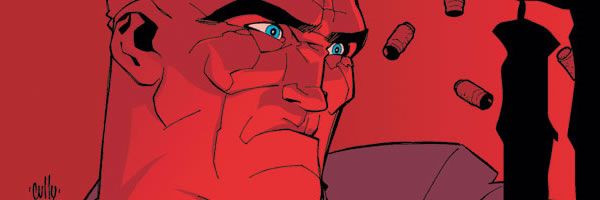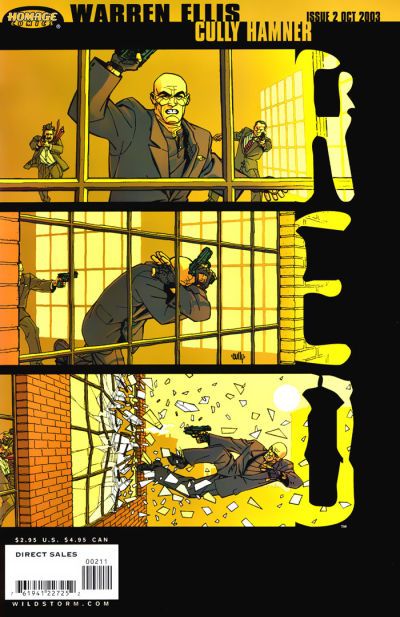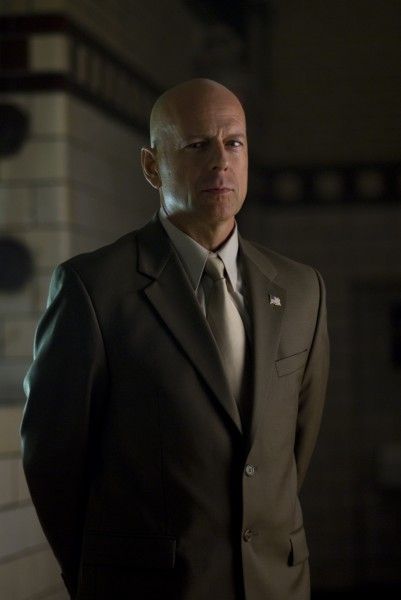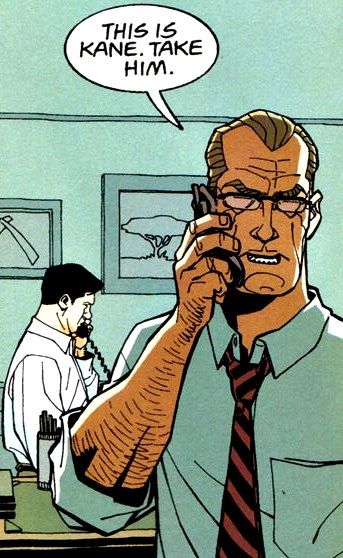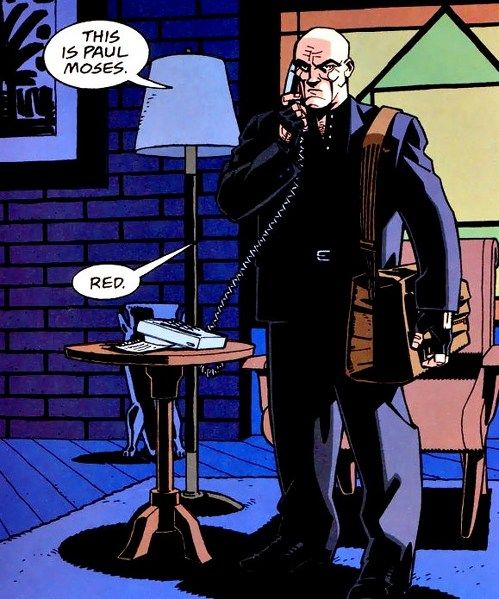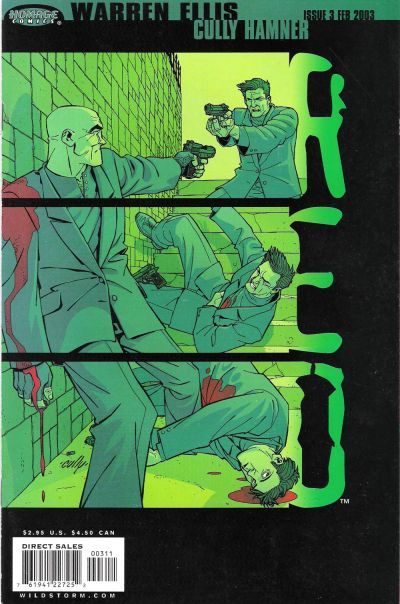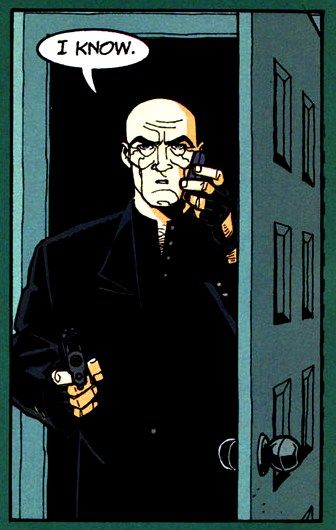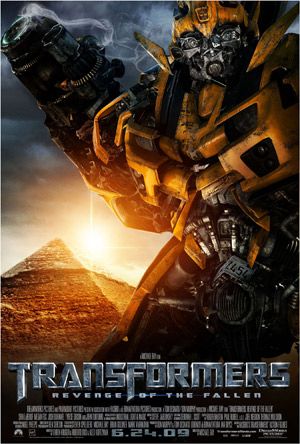Bruce Willis is standing next to some very large shipping containers. He's wearing a black leather coat with a gun in one hand. Next to him is Mary-Louise Parker. She's frightened because someone is firing a gun in their direction. Across from the two of them is John Malkovich. He's also wearing a long coat...but he's holding a large stuffed animal that looks exactly like a pink pig. It's very funny to look at. More gun fire. Malkovich then says, "Can we kill her now?"
The date is April 5, 2010 and I'm in New Orleans on the set of Summit Entertainment's Red. We're in a shipping yard on production day 56 of 60 and the normal heat and humidity of New Orleans is somehow a beautiful sunny afternoon. It's a perfect day to watch Bruce Willis and company try and kill some bad guys.
For more on my set visit as well as an interview with Producer Lorenzo di Bonaventura, hit the jump:
Before going any further, Summit Entertainment has asked me to only write a preview piece of my set visit. This means is I can only scratch the surface of what I saw and did on set. The other thing to know is this was not an exclusive set visit as I shared the experience with a few other online sites.
For those not familiar with Warren Ellis' DC Comics graphic novel of the same name:
Red is the story of Frank Moses (Willis), a former black-ops CIA agent, who is now living a quiet life. That is until the day a hi-tech assassin shows up intent on killing him. With his identity compromised and the life of the woman he cares for, Sarah (Mary-Louise Parker), endangered, Frank reassembles his old team (Morgan Freeman, John Malkovich and Helen Mirren) in a last ditch effort to survive. Also in the cast are Karl Urban, Brian Cox, Richard Dreyfuss, Ernest Borgnine, Julian McMahon, James Remar and Rebecca Pidgeon.
The movie is directed by Robert Schwentke (The Time Traveler's Wife, Flightplan) from a screenplay by Jon Hoeber and Erich Hoeber (Whiteout), and it's produced by Lorenzo di Bonaventura and Mark Vahradian (Salt, Transformers, G.I. Joe: The Rise of Cobra).
If you've read the comic, you're probably wondering how can they make a full length feature out of a 66 page comic. Obviously, screenwriters Jon Hoeber and Erich Hoeber have expanded the story. And before you go thinking the people who made the comic aren't cool with the liberties taken by the production, artist Cully Hamner was on set the day we were there and he was extremely excited about the movie and was 100% on board with the changes. Also, Warren Ellis wrote a post on his blog saying how happy he is with the film. This isn't an Alan Moore situation.
The next thing a reader of the comic might be wondering about the movie's tone since the comic is pretty grim and definitely rated R. The film, on the other hand, is going to be a hard PG-13 and producer di Bonaventura called it an "action/comedy". He also compared the movie to Ocean's Eleven in terms of back and forth banter and True Lies.
Getting back to the set visit (and I wish I could say more but remember: preview piece), we got to watch a few hours of filming, conduct interview with a ton of people like Bruce Willis, Mary-Louise Parker, John Malkovich, Karl Urban, Cully Hamner, Lorenzo di Bonaventura, and a few others. While some set visits have a tough time rounding up people to talk to, the set of Red was almost non-stop interviews. Over the course of the next few months, you'll be able to read all of them as the movie moves towards its released date of October 15th, and I'm sure Summit will be promoting the film at Comic-Con.
But more than anything, the set visit let me know that Red was a movie I should be looking forward to. And I haven't even told you the best part: Helen Mirren plays a wet works sniper and there is a scene where she's firing a 50 caliber machine gun in a long white evening gown! If you don't want to see Helen Mirren firing a 50-cal machine gun , you're crazy.
As I said before, we interviewed producer Lorenzo di Bonaventura while we were on the set, and were lucky enough to speak with him for over 30 minutes. Since hardly any info on the production is online, I'm offering you the interview three ways: I've listed some of our conversation as bullet points, I've provided a transcript of the entire interview, and you can also listen to the interview as an audio file by clicking here. If you want to hear some of the gun fire on set, listen to the audio!
- While some movies are tough to cast, after the production got Willis, Morgan and Mirren, many name actors signed on to play very small parts. Again, like an Oceans movie.
- Going to be a hard PG-13
- They coined the term for "Red"—Retired Extremely Dangerous
- There are two or three big action set pieces
- The opening 4-5 minutes of the movie features Bruce fighting a bunch of commandoes
- A lot of the characters have interconnected storylines that go back a very long time
- They filmed in Toronto and New Orleans and the two cities play Mobile, New Orleans, New York City, Washington DC, upper state New York, Chicago
- Frank (Bruce Willis's character) is old school and doesn't depend on technology. And Marvin (John Malkovich) distrusts all technology. This plays a big part of the film.
- The movie is about trying to figure out why Frank and Marvin are on a "hit list" and many of the others on the list are already dead
- It was a 60 day shoot
-
Here's the full interview. Warning: we discuss significant plot elements.
-
Question: How have you been?
LORENZO DI BONEVENTURA: Good. Good. This has been a fun one to work on.
Yeah, so I guess let’s start with the basic of how did you first get involved with Red?
DI BONEVENTURA: You know Marv actually turned me onto it. And you know what’s been fun is you saw this little kernel sort of evolve into this really large…it just sort of snowballed on us this one. It’s really an interesting project to work on because at first you think, okay well Frank’s a real interesting character but he’s a bit disaffected. He’s been…you know its’ a very almost interior guy. So how do you take that interior guy and turn him into this kind of romp. It’s an old-fashioned word—"romp", but it feels more and more like that. It reminds me of the first Ocean’s Eleven when we put it together where you wrote a nice high script and then George commits and then so and so commits and then so and so commits and it just becomes a different animal. And this one did that. It started with Bruce obviously and I think Morgan was in 2nd and then Helen Mirren and then people start hearing that all these actors are jumping in. So then we started getting incoming calls. Usually you’re out there trying to shake the trees and get them to beg them in any way or form to read your script and come on board, you know? And this time it was the exact opposite as it just kept going. And we’d get calls sometimes where we’d be it’s a small part and they’re like, "We want to be on this movie. This sounds like fun." And so what’s happened is it’s become much…its evolution has been a really interesting one to follow and it’s been interesting to talk to Warren [Ellis, the comic book's author] about it too because he’s been onboard for it and he recognizes how far it’s gone from the original and also appreciates where it’s gone, which is nice to keep the original creator onboard as it takes on a new life.
How far has it gone from the comic?
DI BONEVENTURA: Well, I mean in the sense if you think about the comic’s really about Frank. And now this movie’s about Frank with Bruce and Joe with Morgan Freeman and Marvin with John Malkovich and Sara with Mary-Louise Parker and Victoria with Helen Mirren and I always forget people…Ivan—Brian Cox. So many people to remember, you know? And it…who have I forgotten? I must have forgotten somebody. I always do. Karl Urban with Cooper and Julian McMahon who’s been a big surprise for me. I’ve watched him on that show but I had no idea what a versatile actor he was. Richard Dreyfus came onboard. (gunshots) There you go.
That’s an unusual thing to hear during an interview.
DI BONEVENTURA: Yeah. Duck! I didn’t like that question, next time they’re going to shoot you. In a way, sorry I didn’t fully answer, but in a way it started becoming more than it’s original thing and the tone shifts each time you put a really great actor into it. So it’s really hard to predict today what the tone is. I mean, I watched Ocean’s Eleven dailies and I wouldn’t have said that was the tone we were going to end up with. It was near it, but it wasn’t exactly what I thought it was happening. It’s that chemistry of putting all those pieces together, you know, and that’s the jigsaw of this thing is Marvin and Frank are sort of the buddy movie, Frank and Sara are a romantic comedy. Very Hepburn and Tracey sort of you know impossible…one of the great lines I think is Frank has to kidnap her to save her and he says to her you know, "I didn’t really want to start the relationship this way." It’s that kind of thing. Joe and Frank are sort of mentors and mentee—old buddies, so it’s got all these different dynamics, which has been a real job for Robert [Schwentke], our director, to keep it at an even tone.
Is it like a hard-R or is this going to be more of a PG…
DI BONEVENTURA: This is a hard PG-13.
Is there a lot of comedy that you’re bringing into this?
DI BONEVENTURA: A lot of comedy. It’s really funny. I mean, it’s an action…I guess if I had to be pinned down I’d say it’s an action/comedy as a movie—as a genre. You know we play for real stakes here but you kidnap a girl…you guys haven’t read the script? Have you read the script?
No.
DI BONEVENTURA: Okay, so I’ll give you an example of it: Frank is retired from the CIA and we don’t really know what he is but we know he has this phone relationship with this girl over his pension checks. And it’s clear they kind of like each other and they have this kind of fun sort of little banter and then this is the opening of the movie. And it’ll give you a sense of the tone, but it’s very quiet and it seems like he’s sort of an average guy and he goes to bed and suddenly gets up in the middle of the night and he’s going to the bathroom and shadows are passing down the hallway and 3 commandos attack him. And he takes them out and he realizes they’ve come after him and then he gets ready to leave and another 3 come. So he takes out 6 guys in an action sequence. He goes to the girl’s house. She walks into her apartment. He’s sitting in her apartment. She’s like, "Who are you? Get the hell out of here!" They’ve never met. And he says, "Listen they’re going to come here and kill you. You’ve got to come with me." And she’s like, "Why do I attract all the crazy people?"
(laughter)
DI BONEVENTURA: Okay? So that’s the sort of (more gunshots) and she goes, "Oh my God, I get all the losers." I mean so goes off…instead of being scared she goes off on I can’t believe this is what’s happening to me and then suddenly guys come pulling up to her house and he grabs her and drags her out of this thing and you cut and you see him driving in the car and he’s going on like this, he’s like you know listen, this really wasn’t the way I first wanted to meet you and…and then you cut in the back seat and she’s fully duct taped and abducted. So it has that sort of element going all the way through it. And there’s a lot of banter in it, so it is a different kind of…I mean it’s Ocean’s Eleven in a lot of ways the way Brad and George would banter back and forth. There’s several iterations of that. I mean it’s not like that but it’s Malkovich and Bruce have a real buddy thing going on.
How irreverent is the comedy to say like True Lies?
DI BONEVENTURA: I’d say True Lies, yeah it’s interesting. It’s actually not a bad…it’s a very different movie than True Lies but True Lies had a lot of those elements in it, you know? That sort of notion with his wife in particular. I’d say this movie has its own tone and that played it…
Does the comedy flow into the action or…?
DI BONEVENTURA: It does at times. It tends to be somewhat separate though but I’d say the difference between like True Lies and this is True Lies was making you feel it, you know? And it did it really well. You know, it pushed you very hard. Robert tends to play it very straight, so that’s why I talk about Ocean’s Eleven a little bit more because those guys tended to play it very straight in the middle of whatever was going on, you know? So the tone for this is more…it’s less pushed the way True Lies was.
So Bruce’s character is less last man standing and more you know…his character is a little more lightened up than…?
DI BONEVENTURA: Well what’s interesting is because when you…in the sense of what happens to Frank in this movie—his character—
Because he just wants to be left alone.
DI BONEVENTURA: He starts as a guy who’s not uncomfortable with retirement. And one of the things that we’re…there’s an underlying idea in this movie that we have all related to which is…and we’ve coined the term for "Red"—Retired Extremely Dangerous. Have you guys heard that? And the notion of our society the way we just cast off people, you know whether it’s old or whether it’s dead-end jobs or all the sort of notions of how difficult our society can be on people, this movie sort of has that underlying notion behind it is the empowerment of all those people who are sort of getting left behind, you know? Helen Mirren is a phenomenal wet works sniper. And she runs a B&B and that’s what she does. And when you meet her she’s like serving tea and making flower arrangements and you’re like who’s this lady? What the hell is going on? The next thing you know she’s firing a 50 caliber machine gun, you know? It’s like…
Fucking the greatest movie ever.
DI BONEVENTURA: It is a funny…it is a really funny tone because you meet each of the characters you meet them in a way in their least successful state. And through the process of the movie they band together to win.
It’s just funny you say that because I was joking with Neil I want to see Helen firing an RPG.
DI BONEVENTURA: In an evening gown. In a long white evening gown.
Even better. Can you talk a little bit about getting Helen Mirren into this part? I wasn’t sure what gun she was firing. I wanted to know if she fired…
DI BONEVENTURA: She’s got a few different kinds. We give her as many things as we can give her to shoot.
Did she have to go to weapon training?
DI BONEVENTURA: Yeah, she went through weapon training, yeah, yeah. And she had a ball.
How scary would it be if she already knew how to fire a gun?
DI BONEVENTURA: I don’t know. You wouldn’t know. It’s Helen Mirren.
But actually getting her in the movie, was that a challenge? Was this one of the people…
DI BONEVENTURA: What’s interesting was we didn’t know it at the time but one of the things when she came aboard is she said…I said to her, what was particularly attractive about it? She said, "Well first of all what a great role, but I’ve always wanted to be in a Bruce Willis movie." I was like really? And she goes, "Yeah he’s a very underappreciated actor." She said, "You know he’s really more of a character actor than a movie star and I always thought it would be really fun to be in one of his movies." I said okay, that’s great. I’m glad you came aboard. And Victoria, the character, is a load of fun. You literally meet her in this quaint B&B and the next thing you know she’s…first she’s shooting a sniper rifle, and then later on she’s behind a 50 caliber machine gun shooting at…tearing up an underground garage. Like thousands of rounds. I mean it’s really…we pushed that one as much as we could.
In this film are there a lot of really big, big action set pieces or is it a lot of ones spread throughout the film?
DI BONEVENTURA: It’s pretty evenly spread. I’d say there’s 2 or 3 good sized ones. The opening 4-5 minutes in we have a really great sort of hand-to-hand sequence with Bruce and a bunch of commandoes. And there’s a lot of variety in it. That’s what’s really interesting. There’s car elements. The fight between—Karl Urban plays Cooper who’s the CIA agent who’s going to take out Frank—and there’s a fight between the 2 of them that I’ve never seen in a movie because it’s almost…the closest fight I can remember really was in Bourne in that apartment building when how close they were. They were very close. This one’s more…they’re almost as close but it’s more battering. I mean there’s a lot of UFC moves in it. You know what I mean? I’ve never seen that really in a big movie star fight where you know people are getting spun up and over and smashed down on the things and it’s very aggressive as a fight.
What did you want to see out of Bruce? You know he’s done a ton of cop movies, a ton of like these types of action roles, like was there an element to him that you wanted to bring out more or that he was better for this role?
DI BONEVENTURA: Yeah, when you read it you were like this is Bruce. Please, please say yes.
Well, you see the comic and you’re like that’s Bruce Willis.
DI BONEVENTURA: Please say yes, exactly. So on that level, yes. You know I love Bruce Willis movies—those things that he’s done. What’s different about this and what is going to be fun is he’s supposed to play the really stern Bruce Willis-look that we’ve come to appreciate, but he’s also a guy now in this movie who’s supposed to actually be vulnerable. And have a romantic comedy with somebody and admit that he likes somebody. And what’s interesting is the way we’ve set him up is sort of the extreme of shut down emotionally, and so forcing that person to actually be emotional through the movie is sort of the challenge and the fun of it is watching him…this character come into a scene completely uncomfortable with what is about to transpire, you know? And I’ll go back to that scene I was telling you when he first gets the girl. When he first…you know he’s desperately trying to convince her of what’s going on and yet he’s saying we’ve got to get out of here. They’re going to kill us. They’re coming after you. She’s like, why would they come after me? And then he has to say because they know I like you. And there’s that moment of this guy from that graphic novel, he’s absolutely that guy, having to say that. It’s a really big moment and a really big transition for the character. So there’s a lot of those things that we ask of Bruce through this movie.
But in the comics, doesn’t he also almost kill her?
DI BONEVENTURA: In the comics it’s a little different in that, yes. But in this case he’s put her in jeopardy as opposed to actually going to kill her.
And with kind of splitting the duties of making it a team instead of just being about him, did you want each person—Helen Mirren, John Malkovich—did you want them to kind of take on a particular like sort of role…certain characteristic this is a funny one, this is the straight man, this is…?
DI BONEVENTURA: A little bit. I mean you wanted a group of very distinct personalities. So you know for instance Brian Cox, who’s such a good actor, but he plays a Russian who’s an arch enemy of Frank’s who Frank comes to for help. He brings a very different energy, you know? One of the things that’s really fun is there’s a line that Morgan says that says isn’t this fun bringing the band back together? And it’s sort of that. We do want different notes from everybody. I don’t think we’re that calculated or could be that calculated where we know exactly what the note should be. We know that Marvin as a character—the Malkovich character is one of the wilder characters he’s played. What’s fun about Marvin for instance is everybody thinks Marvin’s crazy or just a complete lunatic and every time Marvin’s right. So everybody goes, what’s he saying? And then he’ll be like, see that helicopter up there? They’re watching us. And everybody’s saying, Marvin come on. And of course the helicopter was watching them. So each guy and each character has a very distinct thing. Brian Cox and Helen Mirren…Helen Mirren tells a funny story where she once fell in love with somebody and then the agency said you’re too close to that guy. You’ve got to take him out. And she said this to…she’s explaining love to Mary-Louise Parker and Mary-Louise Parker says, so what did you do? She goes, I put 3 bullets in his chest. And then later on you discover its’ Brian Cox and that was her way to save him. She didn’t shoot him in the head. So it’s that kind of arithmetic that’s going on there.
Do we get a lot of back-story with Frank or we kind of kept in the dark?
DI BONEVENTURA: You get a little bit of back-story with Frank, you know? You get a very clear what he was about and you get a very clear that he’s a...he was really good at his craft and then what we do progressively is discover new pieces about Frank as you go along. Usually through the relationship, you know? You’re surprised when he goes for help to Morgan Freeman and then he gets sort of like a father-son sort of…or older brother/younger brother sort of dynamic. So you discover a lot from a character point of view, not necessarily a back-story point of view.
I’m curious about was there a lot of debate on where to film this and why New Orleans?
DI BONEVENTURA: We filmed in 2 places. Toronto and New Orleans. And we were looking to find….finance always takes part of this decision, you know? You needed a place that we could actually afford to make this movie and this movie has something that’s a travelogue really. It starts in Cleveland, goes to Kansas City…I always get this sequence wrong…Mobile, New Orleans, New York City, Washington DC, upper state New York, Chicago. I’m probably missing something in there.
So it's kind of a hit list?
DI BONEVENTURA: So it’s putting the puzzle together.
I see.
DI BONEVENTURA: You know, sometimes it’s searching out who somebody was on a list and they find some information, they’re tracking down this, and sometimes it’s just flushing out somebody.
Cleveland isn’t exactly the Mecca for entertainment.
DI BONEVENTURA: No but that’s where Frank lives is Cleveland. So our movie opens in Cleveland. So we needed 2 cities…we needed 2 locations. Once you get to 3 locations, you can almost never afford it. The arithmetic of it just starts getting crazy on you. So 2 cities is already tough but between New Orleans and Toronto it’s a staggering number of variety you can get in looks. So that’s what happened.
Does the majority of the film have Bruce Willis alone, or is there sequences where they’re all in a car together and they’re…
DI BONEVENTURA: The majority of the film, I guess if I had to say it, is probably Bruce, Malkovich and Mary-Louise together—would be the largest number of scenes. Or maybe Bruce and Mary-Louise, I’m not sure. Those 3 are sort of the triangle of the…you spend the most time. You meet Frank, he’s alone. But as soon as he picks up Mary-Louise he’s got her. Then he goes and picks up each person as the band starts coming together. So you have car scenes or you have…where most of them are in the car together and you have scenes where they’re all sitting around a table trying to figure out what the hell is going on.
Earlier you were talking about how the original creator was helping with the direction that the movie was going. Did he actively help write the storyline for the film or was he more of just like a consultant that you went to?
DI BONEVENTURA: More of a consultant. You know he knew we were…the truth is every project I’ve worked on when you’re trying to adapt somebody’s work, it’s a tricky balance, because on the one hand I’ve always felt that it’s important that they like the end product. And on the other, sometimes you’re going in a direction that they may not have a lot to contribute to. I think Warren was really busy so we couldn’t call on him a lot. He’s got a crazy schedule, but we sent him the script, we talked to him about it, what do you think? You know, he came to the set and he said I think online he said, you know it’s not exactly what it is but I like it and I like where it’s going. So I think that was a good result for us.
What’s the role of technology in the film? Because he’s…Frank’s been cast out by the news sort of…are there a lot of gadgets?
DI BONEVENTURA: There’s a fair number of gadgets. I mean Frank is a little bit old-school that way, you know? Frank is not a guy who depends on technology a lot. And Marvin is a character who distrusts all technology.
Right. But technology is a factor in the conflict, right?
DI BONEVENTURA: A little bit. A little bit. I mean, there’s no real sophisticated technology notions. There’s a lot of weaponry. A lot of different kinds of things we use in this thing to shoot or blow up or have fun with, but no I wouldn’t say from a technological point of view this is not that. And in fact it’s sort of old-school in the way it’s who do you know rather than how do you find them on a computer?
Has there been…I mean have you read any criticisms or any fears from comic book fans online that you’re addressing in this film? Do you have anything for the fanboys?
DI BONEVENTURA: Well, I think Frank is the character they’re going to recognize and I think that’s what we were very true to, you know? We tried to keep what was…in essence of what it was. From a storyline point of view it’s very different. It’s much more expansive, you know? And we hoped that they enjoy that fact. Warren enjoyed it. He thought it was a fun thing to have done. I hope they feel that way. It’s always hard to respond to that kind of question and to everybody because…
It’s such a short series…the narrative.
DI BONEVENTURA: Yes, exactly right. As he said, there wasn’t enough to make a movie out of, so given that fact he appreciated where we took it. Look, you’ll never please everybody all the time. I’m sure they’ll be people like how come this isn’t dark enough or how come this isn’t…you know? And I respect that, but for us, the writers really deserve a ton of credit. It’s not a lot of times in Hollywood where the original writer stays all the way through, which I particularly try to have happen on movies I work on, but it’s really difficult. And their first draft, they handed it in and we all looked at each other and went, this is a completely makeable movie right now in the first draft. And it really didn’t change much. I mean we evolved it and we did a lot of things to it but, you know, I don’t even know how to put a percentage on it. It’s more delving into it more than changing it.
Well it so much more dialogue I imagine.
DI BONEVENTURA: It’s a lot of dialogue. A lot of dialogue changes too because certain actors just say things a certain way, you know?
Do you like the way Bruce Willis says his lines?
DI BONEVENTURA: He’s doing great. But it’s interesting, Morgan has a particular way of saying things, you know? Every one of them are so good that when they tell you this is a hard line for us to say, we understand what you want to say, here’s how we’d say it. In general we will go okay, that sounds pretty good to us.
I’m curious, were you on-set the first time John and Bruce were together or did you see the dailies of the first day they were together and what was your reaction?
DI BONEVENTURA: He laughed immediately. It’s a really fun couple. It really is. It’s really sort of Felix and Oscar [of The Odd Couple] . Right away. And what was interesting is making the movie was we started with…in a way the movie evolves is the way the shooting evolved. It’s like we’re working with one actor, then we’re working with 2 actors, then we’re working with 3 actors for awhile, and then 4 and then people kept showing up. So I think one of the hard things about making movies is that there’s sometimes you can sort of settle into a rut. And it’s not necessarily bad or good, it’s just you find yourself in the same sort of thing day in and day out and day out. And what happened to us was we kept having new people join. Oh, Helen Mirren came in today. Oh great. So the movie takes on a different tone each time these actors come in because they came in sort of along the way. And just when you forget about it, then Morgan Freeman showed up and then the movie took again a whole other tone. So for us, it’s been really invigorating because you never really got to feel like you were doing the same thing day in and day out. It just kept changing on you.
Can you talk about what you guys are filming today?
DI BONEVENTURA: This scene here….in the movie one of the pieces of information they’ve uncovered is a list of which Frank is on. It’s a hit list. And they’re trying to discover what the meaning of it is, why he’s on it, where it comes from. And Frank and Marvin actually are two of the people on it. In fact I’ll tell you again to give you a sort of a sense of the tone, they’ve got this list and you realize that a lot of people are dead on the list and they’ve come to New Orleans to find Gabriel Singer. I always forget it…Loeb or Singer…we’ve changed his name and I can never remember which one it is. Anyhow, James Remar plays one of the guys on the list and so they’ve come here to find…try to figure out what the hell is on this list. What do they all have in common? Marvin and Frank are both on it and 6 or 7 of the people are dead on it. This is one of the last people alive other than our 2 guys. And they’re looking for….they try to find him and they find him and all hell breaks loose here. The bad guys find them. They realize what they’re doing. And this is an action sequence. You will see Malkovich carrying around a pink pig. It’s one of the props we have in this movie. I’m just looking to see if we’ve got it anywhere near. Anyway, you’ll see it. It’s one of the gags we have in the movie is when he is…when Frank comes to him he says, okay I’ve got to bring the pig. And he carries this pig around with him. It’s a big stuffed pig for quite awhile and here’s where you’ll discover what’s inside the pig. And Frank has been telling…excuse me Marvin—Malkovich’s character—is telling Frank that they’re watching us, they’re watching us. And this is the scene where of course he was right. And we have helicopters, RPG’s, machine guns, the whole work here.
Are we going to see some helicopters here?
DI BONEVENTURA: I don’t know if we’ll bring in the helicopter here. We’re going to do it at the airport I think because of safety concerns. The beginning of the sequence takes place at the airport, so they’ve come, they’ve found this pilot, they’ve gotten the information, and all hell’s broken loose and they’re running out through one of the freight areas in the airport.
How much is the shooting schedule on this thing? How many days?
DI BONEVENTURA: 60 days.
Where are we in that shoot?
DI BONEVENTURA: We are 56 today.
Oh wow. Wow.
DI BONEVENTURA: Yeah. So we’re all feeling like we’re horses ready to get out of the barn.
Is John Malkovich’s character super physical? Do we get to see like action sequences?
DI BONEVENTURA: You’ll see him do a couple things but Marvin is more…
He’s a brain guy?
DI BONEVENTURA: He’s great with a gun. In fact, he has a showdown that is very funny. There’s a through line, there’s a little gag that we keep playing and I’ll explain it to you if you see pieces of it today, when they arrive here Marvin of course becomes completely suspicious. Frank has picked him up and we met him in the Bayou here actually, which we make Mobile, Alabama like along the swamp there. And he lives underground and you enter his car through the…you enter his house through a car. So Marvin is a real eccentric character and Mary-Louise’s character is kind of like this guy is…keeps saying all these things and he’s kind of nuts. Really? And Frank’s saying basically, you know, when the stuff gets rough, you want Marvin around. Trust me. He may seem that way but he’s usually right. Marvin’s usually right. So we think Frank’s crazy because you’re looking at Malkovich and he doesn’t seem like a guy you would immediately recruit on your mission. He’s a little off, you know? And you come into this train station and they’re arriving here. And they’re walking along having this calm conversation and suddenly he grabs this woman by her hair and yanks her into a corner, puts the gun and says “you’re following us”, and Mary-Louise looks at Frank and like, you’ve got to be kidding me like…and he goes up and says Marvin, it’s okay, it’s okay, it’s okay. She’s got a camera in her bag, I’m telling you. He takes out her bag, dah, dah, dah…nothing. Frank’s like come on Marvin. Take it easy. Now it’s reprised here when that businesswoman shows up, Frank was right and when that businesswoman shows up with an RPG and she’s pissed at him for having pulled her hair and done everything, so she starts calling him an old man and there’s a sequence where he shoots this RPG with a gigantic handgun. And it’s going to be really, I think, a real fun sort of almost western showdown throwback scene.
In a way it also sounds more of a fun-loving than a rated-R flick would be, too.
DI BONEVENTURA: Well, it’s PG-13. Yeah, it is. It is a little bit more fun on that level. You know what’s interesting about it is because I made tons and tons of R-rated movies, and it used to be uncool not to be R. Now you can push PG-13 to a place that in our crazy rating system as long as we don’t say the word fuck more than once, you can pretty much do almost anything you want.
Except now you make this interview an "R".
DI BONEVENTURA: It’s shocking. Did I do that? Okay. Don’t bust me. Don’t bust me.
You’ve got one more to an "R".
DI BONEVENTURA: Oh I only said it once!
You’ve got one more! [laughs] Do all the characters…is it one of these things where everyone’s sort of heard of each other as they’re going around meeting each other?
DI BONEVENTURA: A little bit. There’s a lot of…some people know the reputations and some people actually know each other. But it’s a world where people don’t really…are close friends. So Morgan and Helen know each other and they’re fond of one another, but you never really dive into how deep the relationships are. You get a sense of warmth, but it’s not that kind of world.
Do Bruce and Brian’s characters have a history?
DI BONEVENTURA: Well, Brian’s character when Bruce shows up and Brian’s character is basically like, why shouldn’t I kill you? In fact, he’s got to go into the Russian Embassy to meet Ivan…is his character right? And Marvin says I’m not going in there. And last time I went in there they put weird things on weird places and electrocuted me. So Bruce walks into essentially the lion’s den, if you would, and basically Ivan’s like what are you doing here? And he says, I need your help. He goes, that’s pretty funny. You need…Frank Moses needs my help? Why would I possibly do that? He says I want to break into the CIA. And he goes, oh. And I want the codes and I know you’ve got everything Ivan. And then basically Ivan and he then start a conversation and again, this is a good tonal thing where Ivan says, you know, I can’t forgive you for killing my cousin…Sergei theButcher…Sergei. He goes…Frank goes I don’t know and he goes you know we miss him. We called him the Butcher but we miss him. And he says, he’s not dead. We turned him. He’s running a 7/11 and he weighs 450 pounds and he runs a series of 7/11’s in southern California. And Ivan’s like oh my God. And Ivan says well what about…and then Frank says something back to him like what about so-and-so and he goes I turned her. And so then you begin to see this sort of banter going on where there’s a professional appreciation of each other that goes on in the movie a lot. And that’s maybe a better way to answer your question is they all admire one another even if they are enemies.
Where does this fit on your plate? I mean things you have coming up and things that you’ve just finished with? Where does this fit in for you?
DI BONEVENTURA: Well, this is in between “Salt” and “Transformers 3”.
A great transition.
DI BONEVENTURA: It is three completely different movies. What’s really fun for me is I like making lots of different kinds of movies. You tend to get typecast in our business. This movie’s got a lot of elements of different kinds of movies so it’s really a fun thing. So for me it was really great to be able to play in a movie that has so many different tones.
So this is fun in a different way than “Transformers”.
DI BONEVENTURA: Yeah, no “Transformers” is big and bombastic and adrenalin rushed and this is a lot of nuisance and a lot of detail has to go into this movie between characters that are….we have to have scenes with, you know, 8 or 9 characters talking and they’re very important to keep them interesting and keep them moving and we don’t have the kind of budget that allows us to blow the room up while they’re sitting there.
Are there chances of a sequel do you think? Something discussed at all?
DI BONEVENTURA: You know…no I mean, look the movie certainly has an ending that would allow it. I think the audience is going to have to vote on that one, you know? We’re not going to write a sequel script or anything like that. You know, Ocean’s Eleven we didn’t think we were going to get a sequel. It wasn’t really….we didn’t think of it that way when we set out to do it. We sort of felt like that would be a real fun one to try to recreate that vibe with a bunch of guys. This one is, can we make this sort of older cast play to a really broad audience? That was really sort of the challenge to this. And I think that will be the determination as to whether there’s a sequel or not, you know? Will young guys think this is an interesting enough movie to go to?
Is this your first movie with Summit?
DI BONEVENTURA: It is.
And so you’ve worked for many different places…studios. How can you compare it?
DI BONEVENTURA: It’s really great. I must say it’s been one of the more fun experiences I had in a long time because I know Rob Freedman for a long time from my Warner days, so we’re old, old colleagues but they really….they believe, my experience anyhow, is they believe that we’re in charge of our movie, which is somewhat unique in our business right now where they’re really…
Hopefully it’s true.
DI BONEVENTURA: …yeah. Well that’s the interesting catch of it, you know is that I think in our case our director’s very responsible. I tend to be pretty responsible. There’s a lot of responsible people here, but that could really go sideways if we weren’t. But for me personally what happens is I feel like God, you know what? They’re putting that much trust in me, I’ve got to work twice as hard as opposed to you know when you feel like you’re being told move left, move right, move left, you just sort of go okay fine. Which way do you guys want me to turn? I think it’s allowed for a lot more…the result for me, my experience of it is and I know it’s true for our whole movie for many of us who’ve worked on a lot of big movies, is we’ve actually gotten more time to spend on whether we’re doing it creatively right or wrong than on most movies because we have not had to spend a lot of time explaining ourselves, getting approvals for this, dah-dah-dah-dah. I wasn’t involved in their original setup but their philosophy is okay guys, here’s the money. Make it work. You know, they’re like every studio they’re concerned about how much we’re spending but they’re really allowing you to spend it within that and you know thankfully our dailies were such a place I guess in the first few weeks where they went, you know, okay it’s working. Thank goodness. Keep going. I don’t know what would have happened if it wasn’t, but it’s really a pleasure because we spend an inordinate amount of time explaining ourselves to people on every movie and all that…not that there’s anything wrong with that, but that’s man-hours and man-time that you’re not spending on, well is the scene better? And that’s something for me I really hope I get to make another movie with these guys because that’s been…if anything that’s been the single greatest pleasure. I haven’t had this much fun on making a movie in a long time. It’s really just….it’s very liberating actually.
Do you find yourself having…I mean moving forward when you go into “Transformers 3” do you find yourself having to explain a lot there?
DI BONEVENTURA: Not with Bay, you know? With Bay, no not too much there either, you’re right. You know and also Bay is such a General that it moves at his pace and…but the first movie we had to explain a lot of why we wanted to spend this, what was going on…dah dah dah, but most movies in my experience and in most studios they are…they’re all running in a difficult time right now and they’re concerned about their careers and concerned about the results and Summit is too but they’re sort of…reminds me a lot more of what…I grew up in the Warner Brothers system and our philosophy was once we made our bet, we sort of stuck to it. Which meant it’s up to the filmmakers to deliver it. So it’s wasn’t a particularly intrusive system after once it made its bet. You had to pass a lot of hurdles to get to the go, but once you got there it was like, alright we’re here. We’ve placed our bet and our philosophy at Warner’s was you can’t direct the movie if you’re an executive and you can’t write the movie and you can’t act the movie, so you know, unless they’re going sideways what can you do, you know? It’s up to them to elevate it. And Summit seems to have a lot of that as a philosophy. I’ve never really talked to them about it but the experience is that.
Are any of these actors you’re working with now, are they going to be in any of your future films?
DI BONEVENTURA: Actually Malkovich is in “Transformers 3”.
And what is his role in that?
DI BONEVENTURA: You know we don’t talk a lot about that script, but he’s going to have a lot of interaction with Shia in that movie. And he’s got a really fun character. And he’s going to bring a really interesting spin to that franchise so it’s going to be great. Yeah.
So on that note, we are close to a pig element.
DI BONEVENTURA: Oh great, let’s show the pig. You’ve got to see the pig element for sure! For sure!

